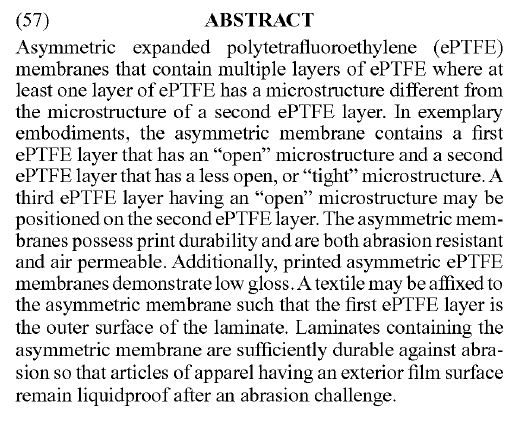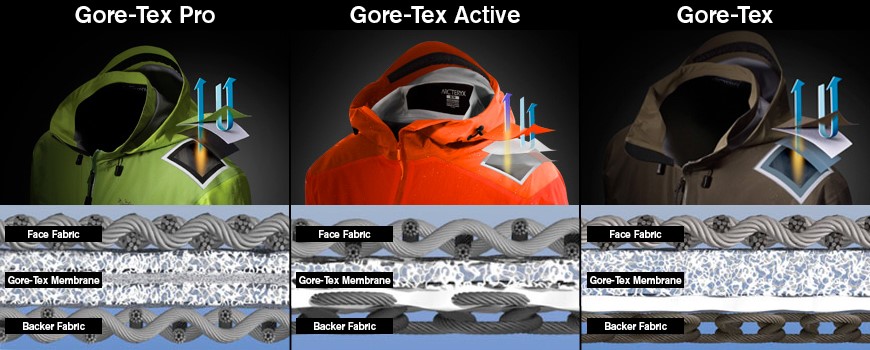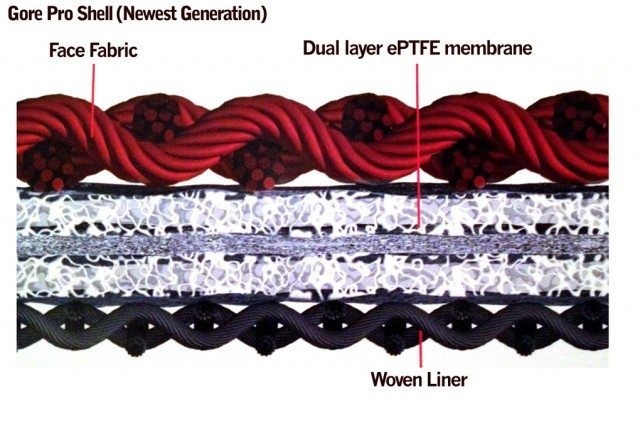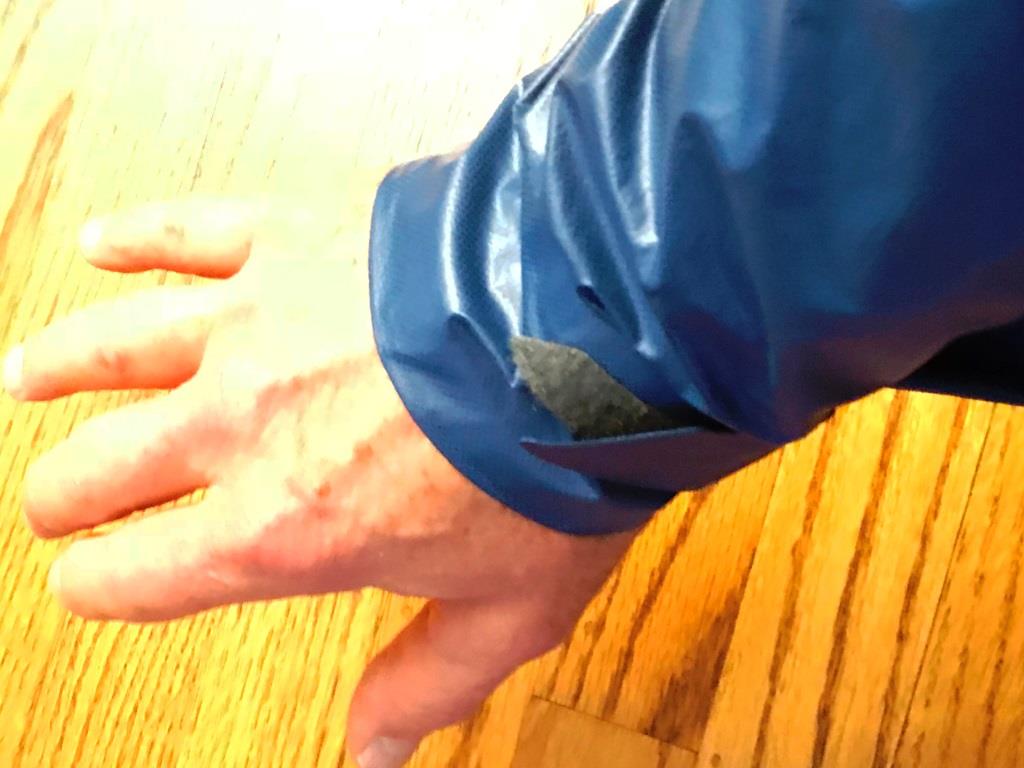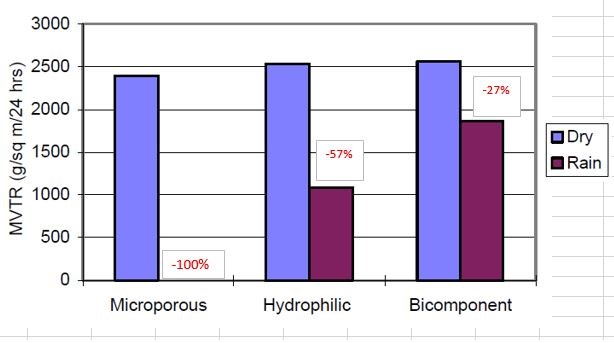Topic
A NEW PARADIGM FOR UNDERSTANDING WPB FABRICS
Forum Posting
A Membership is required to post in the forums. Login or become a member to post in the member forums!
Home › Forums › Gear Forums › Gear (General) › A NEW PARADIGM FOR UNDERSTANDING WPB FABRICS
- This topic has 100 replies, 25 voices, and was last updated 6 years, 8 months ago by
 Eric Blumensaadt.
Eric Blumensaadt.
-
AuthorPosts
-
Feb 28, 2018 at 6:49 pm #3521328
Woubeir,
Thank you for your feedback. Two of your four points were helpful.
Point 1 – You said, “Rab’s Flashpoint-fabrichas/had a claimed MVTR of 60000 and Toray Dermizax NX up to 50000.” Your info was helpful.
Point 2 -This is the relevant Gore-Tex patent abstract:


The picture Gore used to show the 3 layers of ePTFE initially used in Gore-Tex Pro and later ShakeDry. To me it looked the same as my interpretation of their abstract; with the tight microstructure in the center.

In Gore’s own advertising graphics they sometimes refer to their Pro version”s membrane as being a “Dual Layer ePTFE Membrane”.
In /#post-3521225, I said to Michael in part, “The current ShakeDry material is comprised of two layers of PTFE bonded together. The outer FPTE has relatively big pores (patent says open microstructure) and inner PFTE layer has relatively small pores (patent says tight microstructure)”. I didn’t mention a third PTFE layer because the patent abstract inferred it was an option by saying “may be” positioned on the second PFTE layer.
In post # 3521293, you responded in part by saying, “Actually, GTX Pro and Gore Shakedry use 3 layers of ePTFE: the first (most outside layer) has small pores, the second (in the middle) has larger ones and the third (near the skin) has again the small pores and acts as a catch-layer for sweat,”
Your info was helpful.
Point 3 – You said, “you don’t need large pores to be air permeable; you need consistent sized pores”. PTFE has relatively consistent sized pores that can be made “open” microstructures or “tight” microstructures to use Gore’s terminology. I thought that open and large could be used as synonyms.
Point 4 – You said, “Perhaps I’ve read this wrong but it’s not because the RH is 100% where the rain is formed, that the RH is also 100% several 1000 feet below, where we live.”
Where I live, 100 % relative humidity only occurs at ground level during fog (you can clearly see 100% RH). It is not uncommon inland of the ocean to have 100% RH in the clouds and 50-60% RH at ground level before or after a short rain storm.
Feb 28, 2018 at 8:25 pm #3521341There would be a real market (on BPL at least) for a set of simple rain pants in this material in the 4-5oz range. In any kind of brush the DWR is gone off a set of rain pants in a couple of hours.
Mar 1, 2018 at 1:55 am #3521414Richard do you have a photo of the adjustable cuffs?
Mar 1, 2018 at 3:40 am #3521427Brad,
Cuff picture just taken:
 Mar 1, 2018 at 4:36 am #3521444
Mar 1, 2018 at 4:36 am #3521444Woubeir,
Thank you for your challenging suggestion to not discount the 50,000 to 60,000 JIS L 1099-B1 g/m2/24hr MVTR claims for multiple products (ZPacks Ventrice, Kuiu, Bergans, ect). My original guess was wrong, they weren’t all using a MP PU membrane that goes to 0 breathability during hard rain. I discovered that they were all using Torray’s Dermizax NX hydrophilic membrane which, in its present form, has been available since 2010. Hydrophilic membranes only reduce their MVTR ~ 57% after 3 hours of hard rain.
I first calculated the ratio between the eVent MVTR number for the Columbia hard rain test vs its JIS L 1099-B1 test result. A JIS 1099-B1 tests gives approximately 2x the MVTR value as the Columbia hard rain test. I then used that ratio to calculate what the Dermizax NX MVTR value would have been for the Columbia hard rain test. I then reduced this estimated dry value to a wet value using the historical reduction value for hydrophilic membranes during hard rain to contrast it with the Columbia hydrophobic outer technology MVTR which doesn’t appear to decrease appreciably in rain.
it appears that it will meet its MVTR limit at approximately the same sub 7 MET point as the Columbia Outdry EX and EX FW membranes previously reviewed. As a plus, it would breathe better than Columbia alternatives if you used it as wind shirt. As a neutral, its MVTR limit in rain is about the same as the Columbia products tested. As a negative, you would face the big temperature drop from wet out that you wouldn’t with the Columbia products plus the attendant weight increase if stored wet

 Mar 1, 2018 at 5:10 am #3521451
Mar 1, 2018 at 5:10 am #3521451Richard,
about the Gore assymetric membrane: I know, it’s kind of confusing. I will try to read the patent for GTX Pro again.
about the size of the pores: I remember seeing pictures of MP-mebranes that were not AP, even though thoudh there were large pores present. The problem was the size of the pores was not consistent. There was also a picture of an AP MP-membrane: the pores were (much) smaller but all of about the same size.
about the RH: the same here. I just thought I mention this because most people think that because it rains the RH at ground level must be 100%.
Mar 1, 2018 at 10:56 am #3521475the patent is not exactly clear (after all, it’s a patent). Basically. it describes a membrane with two distinct regions, but there can be three or even five. In contrast to what I thought, it seems to appear that the outer regions have the bigger pores.
Mar 1, 2018 at 2:50 pm #3521499Thank you Richard
Mar 1, 2018 at 10:21 pm #3521634Richard,
all my gratitude for the work you’re doing here. I’ve been interested in the “Active WPB” concept for a while and your tests help a lot when building a clothing system. It saddens me that most manufacturers do not publish the HH/CFM values for their products, though they presumably have the data.
Do you think it would be possible to build a CFM tester and a HH tester by yourself, as in DIY? Just for consistent estimation, nothing too shabby (like your .01 CFM accuracy). Or do you think there could/should be some other, more realistic test method for active WPB applicability?
I’m EU based and some of your clothing recommendations are not, and there’s just so many garments I’d like to test for their active WPB applicability.The wild things EPIC shirts are nice, but I’d prefer somewhat civil colors (the coyote lacks CFM) and stretchy materials. I think i’ll try the alpine start hoody, though it’s just conventional DWR. I understand the fabric nevertheless has some “innate” hydrostatic head?
Do you think the active WPB recommendations (~30CFM, >300mm) could significantly differ from person to person as people presumably have different rates of perspiration?
For what it’s worth, I’ve hiked with heavy loads wearing 0 CFM WPB clothing and I’ve been somewhat okay. I get quite hot, but I don’t feel like I sweat that much. So maybe something with 10CFM and a higher HH would be more useful to me. Or could the lower CFM prevent my body heat from keeping the whole garment dry properly?Mar 1, 2018 at 11:58 pm #3521661It looks like Marmot has come out with something “new” EVOdry, a new version of a DWR that supposedly will never wear out and a new Jackets using it; the 7oz Phoenix 13oz Eclipse. My guess is it is just marketing but it does appear that companies know that the future is in DWR that doesn’t wear out or a membrane that doesn’t require a DWR.
Mar 2, 2018 at 12:01 am #3521662Tukkaa,
A DIY HH tester, that has adequate accuracy for this project, has been done by others, that I am aware of.
A DIY CFM tester, that has adequate accuracy for this project, has never been done by others, that I am aware of.
Based on your personal physiology and activity MET, there is variance in what will work acceptably as an Active Waterproof Breathable. At least one US Special Forces Operator has posted to these forums that the 5 CFM & > 300 mm option works best for him.
Mar 2, 2018 at 10:07 am #3521765The question is then: how do you know the HH of a particular windshirt ? There are a lot of models available and such data is rarely mentioned. Now, is it better to have an HH of >300 mm ? Probably yes. Does it make you can’t begin with the active WPB strategy if the HH of your windshirt isn’t at least 300 mm ? No or at least you can partially do it. I’ve been doing that for ages: wearing only the windshirt even when it’s raining up to the point where you need to add or replace it with a WPB. Yes, you will get wet but actually that isn’t a problem as long as you don’t get cold. Is that the ‘active WPB strategy’ ? Well, if that strategy means thet you can add a WPB only if you’re in static conditions, then the answer is no. But my goal is to enjoy the trip, not following a strategy for the full 100%.
Mar 6, 2018 at 12:12 pm #3522640The new Montbell windshirts are out. Different US and Japan market versions; fabrics seem the same but with the usual smaller sizes in Japan windshirts with slightly different features. The Tachyon in the Japan market seems to have no zips, and is called something different:
https://webshop.montbell.jp/goods/disp.php?product_id=1103285
Montbell are claiming higher water resistance and higher breathability than their previous versions. Both versions (hooded, non hood) seem to have non-zip pit vents as well which is different to the past (my Japan market Tachyon bought 2013 in Japan has no pockets or pit zips). Be interesting to see how they fair.
Richard; I just read through your document and this thread. Marvelous work! My experience with my Tachyon when I was in Japan, in crazy conditions (I lived in Tottori which is a VERY windy and wet place. Its always blowing off the sea of Japan/down from Siberia in winter, well over 2m of rain a year, plus the snow…) was that as a very fit and active person (I sweat plenty but have a good tolerance to heat and cold) I was fine in just about any conditions with my Tachyon. Above ~5C I didn’t need anything else underneath, or any other acoutrements, just shorts, darn tough wool socks, runners. Below that I would add in thin gloves and/or WPB mitts that I had, thin beanie, a buff on my neck, at most a thin thermal underwear top. This took me down through the wet and into the sleet and snow. My experience conforms absolutely to what you mention as the training paradigm currently for US SF.
The Japanese (and some scandinavians) use a mesh type next to skin layer once things get down to that kind of level. I didn’t have some but touched it when I was there on my last day. It was nirvana. I wish I could have afforded to buy a whole bunch at the time, but, I knew my ex partner of the time would have killed me. The concept is very sound. “Finetrack” is the main Japanese company that I’m aware of that make it. The stuff is insanely light. I can only think it would enhance performance. Some Japanese like to do a style of “creek running”, where the aim, the purist version of the pursuit, is to stick as closely to the waterline as possible, and go from sea to summit. Hardcore. Obviously, the closer you stick, the wetter you are, regardless of weather. Their clothing systems are designed with this kind of thing in mind. Regardless, Japan is a place where sustained cold, wet conditions greater than 3hr are not hard to find at all…
Finetrack:
their main page for the mesh next-to-skin layer:
https://www.finetrack.com/products/l1-drylayer/
Cheers!
Mar 6, 2018 at 7:48 pm #3522728Adam,
Thank you for your post! Your field experence and new product information are very interesting.
Mar 8, 2018 at 4:22 am #3523050With regard to the Columbia Caldorado. Backpacker Mag measured the weight at 6oz for the medium and a running website measured the medium size at 6.2oz (see below.) Are you positive this is the same material used in the jacket you tested?
The Caldorado also has underarm “fish gill” venting. I wish it had actual pit zips. A part of me wants to get something like the caldorado and have a professional sewer add pit zips to it! A small bead of seamseal and you’re set for no wetting out and more effective convective cooling. Until fabrics attain a magical 7 MET MVTR AND waterproof rating, then I think this is the best that can be hoped for.
Also, I would like to hear your thoughts on the Marmot EVOdry previously mentioned.
https://www.pressreader.com/usa/backpacker/20180101/282162176503581
http://www.roadtrailrun.com/2017/11/light-weight-breathable-waterproof-run.html
Mar 8, 2018 at 5:18 am #3523063Matthew,
The Caldorado is the same material according to Columbia Customer Service. I have not seen or tested this model.
I plan to do a review of a GTI permanent DWR implementation when I become aware of a potentially better “total garment system” implementation than the Outdry EX Featherweight’s. So far all I have done is study the GTI patents and the existing Marmot garment specifications.
My primary concern is that the ~8 oz. Marmot Palisade has no pit zips or equivalent mechanical ventilation. For example, the pockets aren’t mesh to serve as mechanical ventilation sources and they are blocked by any pack’s hip-belt. The front zipper flaps frequently get caught in the zipper. Secondarily, the breathable coating Marmot used was the poorest performing and least durable of their in-house options.
Mar 19, 2018 at 11:39 pm #3525723quick question, apologies in advance-
for those not so scientifically inclined: previous Columbia outdry less likely to wet out, compared to usual products? Featherweight a new entity? more better than prev outdry? Nothing new under the sun?
Thanks, Sam
Mar 19, 2018 at 11:47 pm #3525724I don’t think Outdry EX can wet out. Now, Outdry EX is different than “regular” Outdry
The material is pretty much the same but the featherweight is thinner from my understanding, thus the lighter weight.
Mar 19, 2018 at 11:52 pm #3525725Sam,
Columbia Outdry wets out just like all the others. Only the Columbia Oudry EX does not wet out.
The only benefit that Columbia Outdry provides is in when it is used in a shoe/boot or glove. There is no space between the membrane and the outer fabric to fill with water like conventional construction; only because of this, it will dry out faster.
Mar 20, 2018 at 12:04 am #3525730the new featherweight better than EX, then? For an average backpacker caught in rainy weather for 2-3 d? I have a packa but always interested in new technologies- Thks again for your amazing expertise/willingness to share
Sam
Mar 20, 2018 at 12:19 am #3525733The Colombia Outdry EX Featherweight is made using Oudry EX that will not wet out.
Mar 25, 2018 at 6:16 pm #3526927This threads original link to the pdf analysis has been moved to Here
Apr 11, 2018 at 3:18 am #3529916My thanks to you Richard.
I followed these posts and thoughts from the beginning and just received a Large in Black, it is slightly lighter than the pics which I really prefer- call it dark grey. Tape vanishes almost, 150USD delivered to Australia seemed a bargain I couldn’t refuse!. Can not report on much -comfort on skin-excellent, weight-wrong, vents -excellent, robust-yes seems to be but time will tell.
My L is 220grams or 7.8 ounces. Reminds me of my Marmot Nano AS for ventilation. I like the fact that there is no waist cord but time will tell. I would happily wear this with a tight merino tshirt in warmish weather. Cheers
Apr 11, 2018 at 4:16 am #3529921Grahm,
Thanks for the report. My XL in blue is 7.83 oz. I wonder if there is a weight variance based on the different colored pigment’s weights? See Here.
Many years ago when I ordered an Alpacka packraft, they listed the different weights based on the colors.
Apr 11, 2018 at 4:30 am #3529923No worries at all Richard, or my scale is wrong! Ha ha.
The colour really is pleasing to the eye. You would not call it black.
I wouldn’t expect it to have been much less than that anyway, what maybe, 10 grams? Happy so far.
-
AuthorPosts
- You must be logged in to reply to this topic.
Forum Posting
A Membership is required to post in the forums. Login or become a member to post in the member forums!
LAST CALL (Sale Ends Feb 24) - Hyperlite Mountain Gear's Biggest Sale of the Year.
All DCF shelters, packs, premium quilts, and accessories are on sale.
Our Community Posts are Moderated
Backpacking Light community posts are moderated and here to foster helpful and positive discussions about lightweight backpacking. Please be mindful of our values and boundaries and review our Community Guidelines prior to posting.
Get the Newsletter
Gear Research & Discovery Tools
- Browse our curated Gear Shop
- See the latest Gear Deals and Sales
- Our Recommendations
- Search for Gear on Sale with the Gear Finder
- Used Gear Swap
- Member Gear Reviews and BPL Gear Review Articles
- Browse by Gear Type or Brand.

